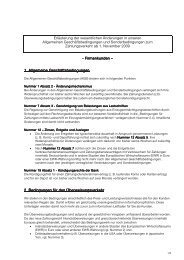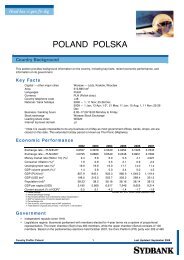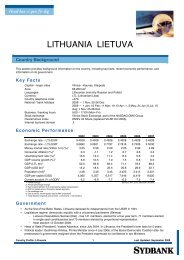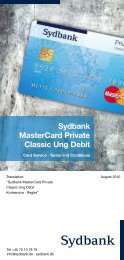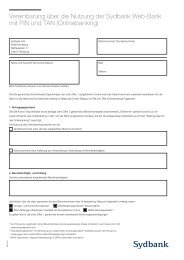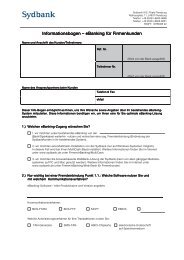SWEDEN SVERIGE - Sydbank
SWEDEN SVERIGE - Sydbank
SWEDEN SVERIGE - Sydbank
Create successful ePaper yourself
Turn your PDF publications into a flip-book with our unique Google optimized e-Paper software.
The Banking Environment<br />
This section includes an overview of the banking market, market dominant banks and background information regarding<br />
the central bank and it's tasks.<br />
Ove rvie w<br />
» There are four main types of banks on the Swedish market: domestic commercial banks (joint stock banks),<br />
foreign banks, savings banks and co-operative banks.<br />
» Commercial and foreign banks have rapidly increased in numbers from 15 to 54 in just over 10 years primarily<br />
because of the entrance of new niche banks (most, purely internet-based) along with the fact that some savings<br />
banks have converted their corporate status to commercial banks. Swedbank (previously FöreningsSparbanken)<br />
has been a facilitator for this; the bank now holds shares in a number of former savings banks. Traditionally, the<br />
group of savings banks have used it as a partner to provide generic products and technical solutions.<br />
» As of September 2008 Sweden had 127 banks, of which there are 29 Swedish commercial banks, 31 foreign<br />
commercial banks, 65 savings banks, and 2 co-operative banks.<br />
» The majority of the foreign banks focus on the corporate and institutional market.<br />
» Generally speaking the Swedish banking industry is somewhat consolidated, however, being a part of the larger<br />
Nordic banking market, which has only seen a few large scale cross-border mergers, leaves open to speculation<br />
how further Nordic consolidation will affect the Swedish market<br />
» The Basel II framework, based on EU directives adopted in June 2006 and numerous interpretation guidelines<br />
issued by the Committee of European Banking Supervisors, entered into force in 2007. However, the framework<br />
will not be adopted simultaneously in all banks, as individual banks may choose not to introduce the new rules<br />
until the beginning of 2008.<br />
Marke t Dominant Banks<br />
» The sector is dominated by the “big four” Swedish banks: Handelsbanken, Nordea, SEB and Swedbank<br />
(previously FöreningsSparbanken). Amid the trend in other European countries the 4 major banks have over the<br />
past decade expanded within non-core banking activities like mortgage lending and life insurance to become<br />
financial conglomerates.<br />
» Two other Nordic financial groups with a strong position in Sweden are Danske Bank and Skandia, the market<br />
leading life insurance company.<br />
» In terms of total assets, the “big four” commercial banks plus Danske Bank cover more than 80% of the market.<br />
» The major domestic cash management banks are Nordea Bank, SEB, Svenska Handelsbanken and Swedbank.<br />
Some of the major international cash management banks have also a presence in Sweden.<br />
The Ce ntral Bank<br />
» Svergies Riksbank or Riksbanken, the central bank is an authority under the Swedish parliament. Riksbanken,<br />
founded in 1668 and considered to be the oldest central bank in the world, only gained its political independence<br />
on 1 January 1999.<br />
» Riksbanken has the sole responsibility for monetary policy and “shall make its own, independent assessments<br />
and must not take instructions from any party”.<br />
» Its main tasks are to maintain price stability and to promote a safe and efficient payment system. Riksbanken’s<br />
interprets price stability to mean low and stable inflation, concurrently with the consumer price index (CPI)<br />
maintained at around 2 per cent per annum with a specified tolerance margin of plus/minus one percentage point.<br />
The bank’s main tool for influencing inflation is the repo rate.<br />
» It also manages gold and foreign exchange reserves and has a monopoly within the supply of banknotes.<br />
» In addition, the bank supervises the Stockholm Stock Exchange’s role as central counterparty and clearing<br />
organisation, monitors clearing and settlement of securities through VPC (The Central Securities Depository), and<br />
it oversees the functionality and risks in the Bankgirot system (clearing of low-value payments).<br />
» The Central Bank takes part in Continuous Link Settlement by providing settlement accounts in SEK and by<br />
participating in the oversight of CLS.<br />
Country Profile: Sweden 4 Last Updated: September 2008




